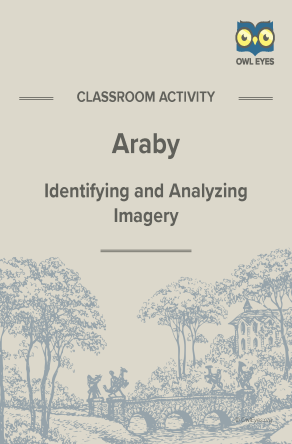Araby Imagery Activity
- 8 pages
- Subject: Imagery, Tone, Lesson Plans and Educational Resources
- Common Core Standards: RL.11-12.1, RL.11-12.4, RL.11-12.5, RL.9-10.1, RL.9-10.4
Additional Araby Resources
Product Description
James Joyce’s “Araby” was first published in 1914 in his short story collection Dubliners. The story is drawn from Joyce’s own childhood in Dublin and tells the tale of a boy who falls in love with a neighbor girl. Seeking a token of his love for her, the boy goes to the Araby bazaar to buy her a gift. Throughout the story the boy is flooded with powerful romantic emotions that he struggles to understand. As a child growing up in a strict catholic culture, he has no context for his feelings of romantic love. As in most of his work, Joyce uses striking imagery to render the outer and inner worlds of the story. Through sights, sounds, smells, and feelings, we experience the outer world of Dublin and the inner world of the protagonist.
Skills: analysis, drawing inferences from text, close reading, identifying the relationship between words
About This Document
The Owl Eyes Imagery worksheet gives students an opportunity to practice identifying and analyzing imagery. Imagery within a text creates a sensory experience that can connect readers to a text’s setting, atmosphere, or overall aesthetic. Studying imagery will help students understand how narrators or principal characters feel. The main components of this worksheet include the following:
- A brief introduction to the text
- A handout on types of imagery with examples from classic texts
- A step-by-step guide to activity procedure
- Selected examples of imagery from the text
In completing this worksheet, students will learn to identify and analyze different kinds of imagery in order to develop close reading skills and identify the effect imagery has on their reading experience.







